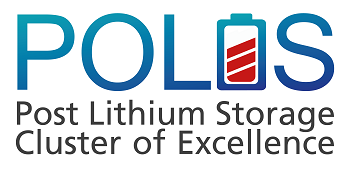HIU-Newsletter
You a scientist yourself? A journalist, a political decision-maker or business representative? In our newsletters we compile the latest battery research news for you. Specially tailored to your personal area of interest.
The electron microscopy and spectroscopy research group at HIU is an interdisciplinary group in which physicists, chemists, materials scientists and geologists combine their research efforts.
The main focus is on the finding of the structure and morphology of novel battery materials and components – therefor we use a combination of directly mapping methods up to the atomic resolution and spectroscopic methods for chemical characterisation. In cooperation with other research groups at HIU the purpose of our work is to develop an understanding of the correlation between structure and electrochemical properties and stability. We are developing new in-situ TEM methods in order to map directly the structural changes during electrochemical cycling of miniaturised batteries.
(information will be uploaded shortly)
The electron microscopy and spectroscopy group is operating the following equipment at the Institute of Nanotechnology (INT) in Karlsruhe, which is available for research activities within HIU:
Transmission electron microscopy (TEM) enables characterization of materials by direct imaging with up to atomic resolution. The image information can be locally correlated with spectroscopic techniques (EELS/EFTEM and EDX) to provide semi-quantitative elemental composition/maps with sub-nanometer resolution. All of these techniques can also be performed in-situ, e.g. during heating, electrical biasing or straining to directly correlate structural changes and materials properties. Furthermore, for complex three-dimensional structures, electron tomography can be used to generate a 3D representation of the material with a spatial resolution of 1–2 nm.
The FEI Strata 400S and the Zeiss Auriga 60 Dual Beam FIB are both a combination of a scanning electron microscope (SEM) and a focused ion beam (FIB) system, which allows imaging and structuring of materials at the nanoscale. The focused gallium ion beam can either be used for ion imaging or to cut predefined patterns or images in the surface of a solid. At the same time, the SEM can be used to image the nanostructures generated by FIB. In addition, it is possible to locally deposit C, Pt or W from precursor gases using the electron or ion beam. Using this combined approach it is possible to
(images will be uploaded shortly)
The electron microscopy and spectroscopy group is partner in a number of national and international collaborations and projects. Battery related projects are pursued as part of the following projects.
“Novel in situ and in operando techniques for characterization of interfaces in electrochemical storage systems”. The objective of the project is to develop methodologies for determining in detail the role of interface boundaries and interface layers on transport properties and reactivity in lithium batteries, and to use the knowledge gained to improve performance.
The Karlsruhe Nano Micro Facility (KNMF) is a Helmholtz user facility operated at the KIT in Karslruhe providing access to a varierty of nano- and micro structuring and characteriaztion facilities.
(information will be uploaded shortly)
The electron microscopy and spectroscopy group is operating the following equipment at the Institute of Nanotechnology (INT) in Karlsruhe, which is available for research activities within HIU:
Transmission electron microscopy (TEM) enables characterization of materials by direct imaging with up to atomic resolution. The image information can be locally correlated with spectroscopic techniques (EELS/EFTEM and EDX) to provide semi-quantitative elemental composition/maps with sub-nanometer resolution. All of these techniques can also be performed in-situ, e.g. during heating, electrical biasing or straining to directly correlate structural changes and materials properties. Furthermore, for complex three-dimensional structures, electron tomography can be used to generate a 3D representation of the material with a spatial resolution of 1–2 nm.
The FEI Strata 400S and the Zeiss Auriga 60 Dual Beam FIB are both a combination of a scanning electron microscope (SEM) and a focused ion beam (FIB) system, which allows imaging and structuring of materials at the nanoscale. The focused gallium ion beam can either be used for ion imaging or to cut predefined patterns or images in the surface of a solid. At the same time, the SEM can be used to image the nanostructures generated by FIB. In addition, it is possible to locally deposit C, Pt or W from precursor gases using the electron or ion beam. Using this combined approach it is possible to
(images will be uploaded shortly)
The electron microscopy and spectroscopy group is partner in a number of national and international collaborations and projects. Battery related projects are pursued as part of the following projects.
“Novel in situ and in operando techniques for characterization of interfaces in electrochemical storage systems”. The objective of the project is to develop methodologies for determining in detail the role of interface boundaries and interface layers on transport properties and reactivity in lithium batteries, and to use the knowledge gained to improve performance.
The Karlsruhe Nano Micro Facility (KNMF) is a Helmholtz user facility operated at the KIT in Karslruhe providing access to a varierty of nano- and micro structuring and characteriaztion facilities.
 Prof. Dr. Christian Kübel Research Group Prof. Christian Kübel
Prof. Dr. Christian Kübel Research Group Prof. Christian KübelORCID: 0000-0001-5701-4006
Scopus Author ID: 6701623681
ResearcherID: A-1720-2009
Loop profile: 449468
You a scientist yourself? A journalist, a political decision-maker or business representative? In our newsletters we compile the latest battery research news for you. Specially tailored to your personal area of interest.




Helmholtz Institute Ulm Electrochemical energy storage (HIU)
Helmholtzstraße 11
89081 Ulm
Germany
Tel.: +49 0731 5034001
Fax: +49 (0731) 50 34009